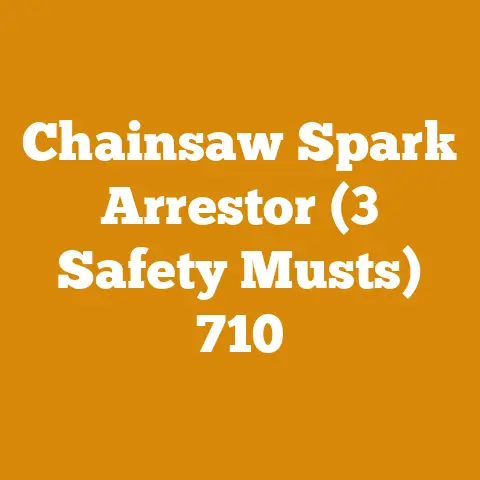How to Identify Jonsered Chainsaw (4 Clues to Look For)
Ever thought about chainsaws causing allergies? It’s not the saw itself, but the whirlwind of sawdust and debris they create. My first encounter with a Jonsered chainsaw was exciting, but it also had me sneezing like crazy. If you’re prone to allergies like me, you might want to keep some allergy meds handy before you start sawing. Now, let’s explore how you can spot a Jonsered chainsaw with ease and confidence.
1. Look for the Distinctive Red Color
The Red You Can’t Miss
Jonsered chainsaws are renowned for their vibrant red color. Picture this: you walk into a tool shop or check out a yard sale, and among the sea of gray and black tools, the Jonsered’s fiery red stands out like a beacon.
Why Red Matters:
Jonsered’s choice of color isn’t just about aesthetics; it’s about brand identity. The red color has become synonymous with Jonsered’s reliability and power.
A Personal Tale:
I vividly recall the first time I spotted a Jonsered chainsaw. I was on a logging site, surrounded by various chainsaws. Yet, the Jonsered’s red hue caught my eye immediately. It was like spotting an old friend in a crowded room!
Action Steps:
- Scan for Red: When browsing chainsaws, start by looking for the bright red finish.
- Check Consistency: Ensure the color is even and not faded, which could indicate excessive wear or repainting.
Tip:
If you’re buying used, a consistent red color without chipping is a good sign of proper care.
2. Spot the Logo and Branding
The Logo: Your Trusty Guide
Jonsered’s logo is more than just a name—it’s a mark of authenticity. Recognizing this logo can save you from mistakenly purchasing an imitation.
The Logo Hunt:
Jonsered’s logo is often prominently displayed on the side or top of the chainsaw. It’s sleek and unmistakable.
My Experience:
I once stumbled upon what seemed like a great deal on a “Jonsered” chainsaw at a flea market. It looked right at first glance, but something felt off. The logo was slightly skewed, an obvious sign upon closer inspection that it was a counterfeit.
How to Identify:
- Locate the Logo: Check the engine housing and handle areas.
- Examine Closely: Is it clear and well-placed? Fake logos often appear smudged.
- Compare with Authentic Images: Use your phone to find official images online for comparison.
Warning:
Watch out for fake logos—some sellers might try to pass off other brands as Jonsereds by altering logos slightly.
3. Model Numbers and Serial Tags
The Devil is in the Details: Numbers Tell All
Every Jonsered chainsaw comes stamped with a model number and serial tag. These aren’t just numbers; they’re the key to unlocking information about your saw.
Numbers Don’t Lie:
These numbers help verify authenticity and provide insights into the saw’s history.
Here’s How I Do It:
I always start by locating these numbers on the saw. They’re usually found on the engine housing or near the handle.
Steps to Verify:
- Find the Serial Tag: Look around the engine housing.
- Write Down the Numbers: Don’t rely on memory—jot them down.
- Verify Online: Use official Jonsered resources or manuals to cross-reference these numbers.
Warning Box:
If numbers seem tampered with or are missing, it could be a sign of theft or unauthorized modifications.
4. Unique Design Features
Design Speaks Louder Than Words
Jonsered chainsaws boast unique design features that distinguish them from other brands. Recognizing these can help ensure you’re looking at an authentic piece.
Design That Speaks Volumes:
- Ergonomic Handles: Designed for maximum comfort during prolonged use.
- Unique Switch Placement: The controls are strategically placed for easy access.
- Distinct Air Filter Cover Design: A signature feature in many Jonsered models.
My Example:
A buddy of mine once showed me his “new” Jonsered chainsaw, but something was off. The handle was uncomfortable, and the air filter cover didn’t match what I knew it should look like. Turns out, it wasn’t a Jonsered at all!
Tips Box:
- Familiarize yourself with Jonsered’s design by visiting stores or viewing online galleries.
- Handle one in person if possible to get a feel for its unique ergonomics.
Safety First!: Essential Precautions
Before diving headfirst into identifying your chainsaw, remember that safety is paramount.
- Protective Gear: Always wear gloves and goggles when handling chainsaws.
- Allergy Check: If you’re sensitive to dust or oils, take preventive measures.
- Proper Handling: Never start up a chainsaw without being fully aware of its operation and safety protocols.
Materials Needed for Identification
To successfully identify your Jonsered chainsaw, gather these tools:
- Smartphone or computer for quick research
- Pen and paper for jotting down model numbers
- Access to Jonsered’s official resources online
- Safety gear (gloves, goggles)
Common Questions and Concerns
Q: Can I trust the paint color alone?
A: While red is a good indicator, always back it up with other identifying factors like logos and model numbers.
Q: What if there’s no serial number?
A: This is suspicious. It could indicate theft or tampering, so proceed with caution.
Q: Are there common counterfeit features?
A: Yes, fakes often have poorly executed logos and mismatched paint jobs. Always verify details carefully.
Final Thoughts and Next Steps
Congrats! You’re now equipped to identify a Jonsered chainsaw with confidence. Whether you’re buying, selling, or simply curious about your tool collection, these tips will guide you through the process.
Remember to always verify through multiple clues before making any purchase decisions. If you’re still unsure, reach out—I love discussing all things chainsaws!
Happy cutting!






